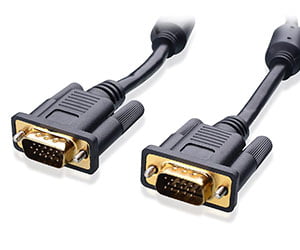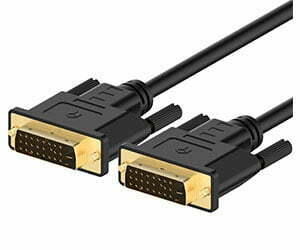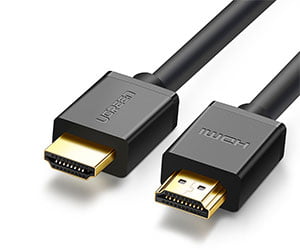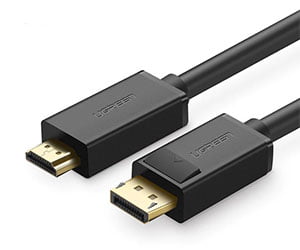Display technology has undergone many changes over the years with new innovations sweeping the consumer market on a regular basis.
We have come a long way from the old days of large, clunky CRT monitors to the cutting edge, high refresh rate, high-resolution displays that are currently available in the market.
During this time, display connector standards have also gone through many different transformations.
Here, we will take a look at four important milestones in the history of display connectors and study their important characteristics and pros and cons.
With this information, you would be able to choose the right display technology for your requirements based on the unique demands of your use case.
VGA Cable
The oldest connector among the four, VGA, stands for Video Graphics Array and is also commonly referred to as D-Sub or PC-RGB.
This is the connector that you would find on older CRT monitors, first-generation flat-screen monitors, and projectors.
This is the only connector in this comparison that uses an analog signal.
If you have legacy hardware, you can consider using this connector which, in theory, can output a resolution of up to 1080p.
However, since the analog signal needs to be converted to digital before output, the image can degrade more and more as you increase the resolution.
All the other connectors in this comparison would be better choices for better image quality, resolution, and refresh rates.
However, since a lot of people still use legacy hardware, this standard is likely to be relevant for a while longer into the future.
DVI Cable
The DVI standard has a number of different connector formats. Predominantly a digital connector that slowly started replacing VGA in consumer monitors and graphics cards, DVI stands for Digital Visual Interface.
The DVI-A standard still uses analog signals. However, both of the most commonly used formats, DVI-D and DVI-I, have support for digital signals.
While DVI-D is fully digital, DVI-I carries an integrated signal that contains both analog and digital elements.
If you use a DVI connection, it is important to understand the different versions of the standard and the differences it can make in terms of abilities.
In its basic or single-link version, the DVI standard is capable of a data rate of 3.96 Gbps. This allows for resolutions of up to 1920 x 1200 which makes this a good choice if you are looking to game at 1080p.
On the other hand, dual-link DVI supports a data transfer rate of 7.92 Gbps, allowing for resolutions up to 2560 x 1600. This makes dual-link DVI an apt choice for 1440p gaming.
A good use case of this standard would be gaming at 1080p with a high refresh rate monitor.
At 1080p, DVI can output up to 144Hz which can be perfect for competitive gaming.
However, if you are looking to operate at high resolutions, this might not be a good choice as there is no support for 4K.
While purchasing hardware, it’s crucial to remember that this standard is on its way to being phased out in favor of the more capable and more versatile HDMI and DisplayPort connection standards.
HDMI Cable
High Definition Multimedia Interface or HDMI is among the most widely used display connectors all over the world.
You can find these connectors on laptops, graphics cards, monitors, televisions, gaming consoles, and a host of other gadgets.
The most paramount selling point of this format is the ability to carry both video and audio signals in uncompressed forms, making this a one-cable solution for most multimedia applications.
Since its inception in 2002, the HDMI standard has gone through many changes and revisions.
The two most common formats currently found are version 1.4 and the more recent 2.0. With the older 1.4 version, data speeds would reach up to 10.2 Gbps, allowing for a maximum resolution of 4K with a 30Hz refresh rate.
The HDMI 2.0 specification can top out at 18 Gbps, enabling you to use the connector for 4K content at 60Hz. You can also enjoy 1080p gaming at 144Hz.
There are also differences in terms of color depth, which is important due to the advent of HDR content both in media and games.
HDMI 1.4 was limited to an 8-bit color depth while version 2.0 has native support for 10-bit and 12-bit color. This makes the latest version the perfect choice if you are looking to enjoy the HDR content.
With HDR, there is an expanded dynamic range in the image. This means a much greater difference in detail and brightness between the darkest and lightest parts of an image.
Years prior, getting the image to bias at either end of the spectrum would result in loss of detail in the other end. This is no longer a problem with HDMI 2.0.
This is especially relevant because there is a lot more HDR content around nowadays with many smartphones including an HDR mode in their cameras, many games building in HDR graphics, and leading video streaming services featuring HDR content.
In certain use cases, HDMI would become an automatic choice as it carries both video and audio signals, a significant improvement over the older DVI standard.
Many devices also have native support for HDMI-CEC or HDMI Consumer Electronics Control, which allows you to control the power state of multiple devices using the same remote if they are connected through HDMI.
Apart from the standard HDMI connector, HDMI can also be implemented with mini and micro-sized connectors that are often found on portable devices like laptops and tablets.
DisplayPort Cable
DisplayPort is the newest standard of the lot and has the potential to become the standard of choice for manufacturers in the future.
This display standard can also carry both video and audio and brings to the table the possibility of both significantly higher resolutions and refresh rates.
While DisplayPort 1 and 1.1a can push out a 1080p resolution at 144Hz, DisplayPort 1.2 and 1.2a have the ability to output 1440p at 144Hz. With version 1.3, you can drive 4K resolution at 120Hz while version 1.4 can go up to 144Hz on 4K using DSC or Display Stream Compression.
Another exciting aspect of DisplayPort is much-enhanced data rates. With version 1.4, you can expect data rates upwards of 25 Gbps.
This realistically opens up the possibility of enjoying content at resolutions higher than 4K in the future. Theoretically, this rate of data transfer is enough to reach resolutions like 7680 x 4320, commonly known as 8K.
One of the most impressive features of the DisplayPort standard is MST or Multi-Stream Transport.
Using this, you can daisy-chain two or more compatible displays over a single DisplayPort connection using the appropriate connectors. Depending on the specification you are using, you would be able to connect multiple displays being limited only by the maximum bandwidth supported by the standard.
This way, you have a ready solution at hand if you want to create a multi-monitor setup while retaining great image quality and resolution.
DisplayPort also seems the logical choice going forward if you want to take advantage of the G-Sync protocol from Nvidia or the FreeSync / Adaptive-Sync protocols from AMD.
The DisplayPort specification is also exciting for people using modern laptops as the specification can be implemented using modern high-speed interfaces like USB-C and Thunderbolt. In fact, with these versatile connectors, a single port can be used for multiple applications including charging, docking, display, and connecting peripherals.
Salient Points
It’s vital to learn about these display connectors and specifications so that you can choose your hardware wisely depending on your use case scenario.
If you are looking to go all-out and embrace very high resolutions, DisplayPort can be an excellent choice that is the most future-proof among all the options listed here.
This is also perfect for small form factor machines that do not have a lot of I/O real estate but still feature excellent display capabilities with no compromises.
HDMI is still a versatile, feature-rich standard that is likely to get even better with future revisions. This is also a standard that you are likely to use with appliances like televisions and set-top boxes.
While VGA has almost entirely been phased out and DVI is also well on its way, there can be specific use cases where you might need these specifications.
However, it is important to keep in mind that upgrading your components in the future will definitely lead to compatibility issues if using these connectors.




